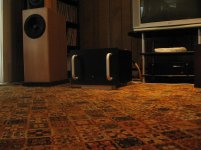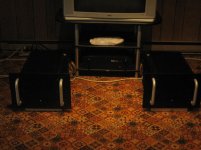Hello everyone,
One of my monoblocks suffered a minor failure with one of the supply caps.
Apparently one of the connections worked it's way loose on the cap terminals and caused some arcing which in turn caused tremendous heat to the terminal(s) of one of the 4 33kmf 50V PS cap and physically burned the star ground wire and the terminals of the cap itself. So luckly no damage to the output stage, and infact music was still being produced while the burning smell became evident. In the process of replacing the caps (all 4) I made an effort to replace them exactly to no avail, so I ended up finding 4 NEW 33kmf with higher voltage rating and 95C (instead of 85C original) and closer tolerance. Everything went together perfectly and sounds just a beautiful (Thank you Mr. Pass) and so for the big question - Why is the amp running about 6 deg.F
(142 F) hotter than before and about 9 deg. F hotter than the other unit? Could the bias have drifted because of perhaps a better quality caps? The sinks are pretty hefty. The temp. reading is actually being measured at the direct opposite side (Fin side) of where the IRFP240's are mounted. 5" further down the fin is reading 125 deg F. What is going on here?
Thank for all of the member of DIY.com for this informative site.
Cheers,
jritota
😕
One of my monoblocks suffered a minor failure with one of the supply caps.
Apparently one of the connections worked it's way loose on the cap terminals and caused some arcing which in turn caused tremendous heat to the terminal(s) of one of the 4 33kmf 50V PS cap and physically burned the star ground wire and the terminals of the cap itself. So luckly no damage to the output stage, and infact music was still being produced while the burning smell became evident. In the process of replacing the caps (all 4) I made an effort to replace them exactly to no avail, so I ended up finding 4 NEW 33kmf with higher voltage rating and 95C (instead of 85C original) and closer tolerance. Everything went together perfectly and sounds just a beautiful (Thank you Mr. Pass) and so for the big question - Why is the amp running about 6 deg.F
(142 F) hotter than before and about 9 deg. F hotter than the other unit? Could the bias have drifted because of perhaps a better quality caps? The sinks are pretty hefty. The temp. reading is actually being measured at the direct opposite side (Fin side) of where the IRFP240's are mounted. 5" further down the fin is reading 125 deg F. What is going on here?
Thank for all of the member of DIY.com for this informative site.
Cheers,
jritota
😕
Attachments
Pass DIY Addict
Joined 2000
Paid Member
Two quick guesses to answer your question about higher temp with the new caps:
1) newer and better caps have lower ripple voltage than the older caps, thus a more consistent rail voltage than before?
2) newer and better caps have lower ESR (resistance) than the older caps, thus a higher rail voltage than before?
Can you compare the DC voltage on your power supply caps of the two amps?
Eric
1) newer and better caps have lower ripple voltage than the older caps, thus a more consistent rail voltage than before?
2) newer and better caps have lower ESR (resistance) than the older caps, thus a higher rail voltage than before?
Can you compare the DC voltage on your power supply caps of the two amps?
Eric
2) newer and better caps have lower ESR (resistance) than the older caps, thus a higher rail voltage than before?
Can you compare the DC voltage on your power supply caps of the two amps?
Eric
This is exactly what I was thinking
Sounds like a good place to start. I don't know why I didn't think of that first.
Will give it a shot as soon as time warrants. Average temp across that bank of sinks is 135 F. Is it time for some forced air in the case? Phoey!! I hope not. As you can see the cases are huge, innards are well spaced apart and the back plate of the sinks are 5/8" thick, giving good heat distribution throughout the whole sink area. Any more opinions?
Thanks so much Eric
Joe
Will give it a shot as soon as time warrants. Average temp across that bank of sinks is 135 F. Is it time for some forced air in the case? Phoey!! I hope not. As you can see the cases are huge, innards are well spaced apart and the back plate of the sinks are 5/8" thick, giving good heat distribution throughout the whole sink area. Any more opinions?
Thanks so much Eric
Joe
- Status
- Not open for further replies.

